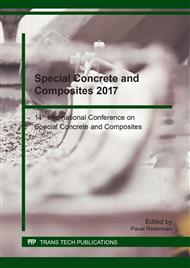[1]
García-Díaz I., Palomo J.G., Puertas F.: Cem. Concr. Comp. 33, 1063 (2011).
Google Scholar
[2]
K. Tkáčková, Mechanical Activation of Minerals, Minerals engineering, 11 (1991) 4, 185.
Google Scholar
[3]
N. Vdovic, I. Jurina, S.D. Skapin, I. Sondi, The surface properties of clay minerals modified by intensive dry milling-revisited, Applied Clay Science. 48 (2010) 4, 575–580.
DOI: 10.1016/j.clay.2010.03.006
Google Scholar
[4]
F. Garcia, N.L. Bolay, J.L. Trompette, C. Frances, On fragmentation and agglomeration phenomena in an ultrafine wet grinding process: the role of polyelectrolyte additives, International Journal of Mineral Processing, 74 (2004) 10, S43-S54.
DOI: 10.1016/j.minpro.2004.07.001
Google Scholar
[5]
J. Hrachova, P. Komadel, V.S. Fajnor, The effect of mechanical treatment on the structure of montmorillonite, Materials Letters, 61 (2007) 16, 3361–3365.
DOI: 10.1016/j.matlet.2006.11.063
Google Scholar
[6]
N. Kotake, M. Kuboki, S. Kiya, Y. Kandac, Influence of dry and wet grinding conditions on fineness and shape of particle size distribution of product in a ball mill, Advanced Powder Technology, 22 (2011) 1, 86–92.
DOI: 10.1016/j.apt.2010.03.015
Google Scholar
[7]
G. Bumanis, D. Bajare, Compressive strength of cement mortar affected by sand microfiller obtained with collision milling in disintegrator, Procedia Engineering (2016) Modern Building Materials, Structures and Techniques, MBMST (2016).
DOI: 10.1016/j.proeng.2017.02.037
Google Scholar
[8]
Hint, J.A. The Basic Problems of Mechanical Activation Reports of the 5th Symposium on Mechanochemistry and Mechanics of Hard Materials 1977: p.14 – 32.
Google Scholar
[9]
Kipnis, B.M. Analysis of Prospects for the UDD – Technology in the Field of Polymeric Materials UDD – Technology Abstracts II, SKTB 1983: p.44 – 46.
Google Scholar
[10]
ČSN EN 196-6 Methods of testing cement – Part 6: Determination of Fineness.
Google Scholar
[11]
ČSN EN 196-1 Methods of testing cement – Part 1: Determination of strength.
Google Scholar
[12]
ČSN EN 196-3 Methods of testing cement – Part 3: Determination of setting times and soundness.
Google Scholar


